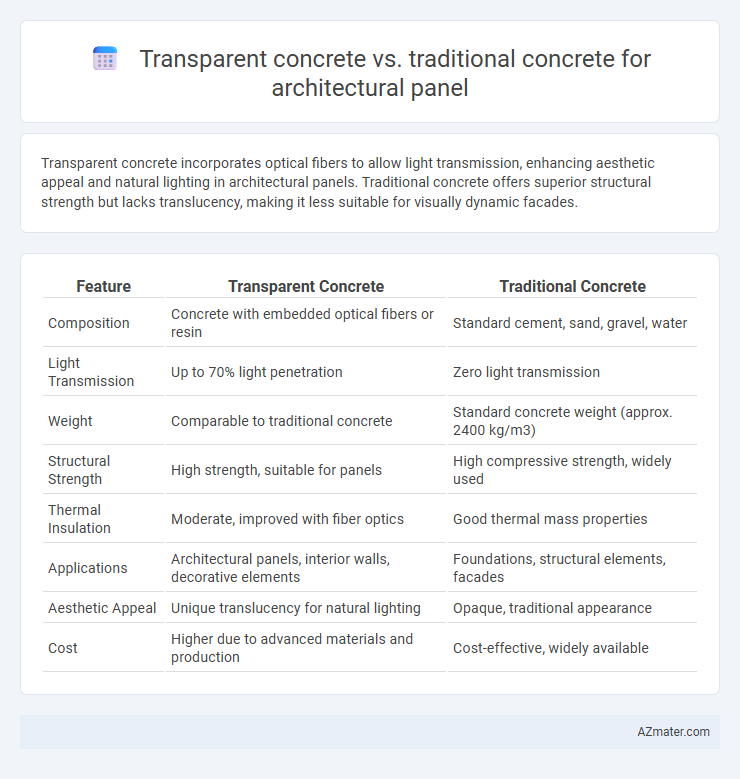Transparent concrete incorporates optical fibers to allow light transmission, enhancing aesthetic appeal and natural lighting in architectural panels. Traditional concrete offers superior structural strength but lacks translucency, making it less suitable for visually dynamic facades.
Table of Comparison
| Feature | Transparent Concrete | Traditional Concrete |
|---|---|---|
| Composition | Concrete with embedded optical fibers or resin | Standard cement, sand, gravel, water |
| Light Transmission | Up to 70% light penetration | Zero light transmission |
| Weight | Comparable to traditional concrete | Standard concrete weight (approx. 2400 kg/m3) |
| Structural Strength | High strength, suitable for panels | High compressive strength, widely used |
| Thermal Insulation | Moderate, improved with fiber optics | Good thermal mass properties |
| Applications | Architectural panels, interior walls, decorative elements | Foundations, structural elements, facades |
| Aesthetic Appeal | Unique translucency for natural lighting | Opaque, traditional appearance |
| Cost | Higher due to advanced materials and production | Cost-effective, widely available |
Introduction: The Evolution of Concrete in Modern Architecture
Transparent concrete integrates optical fibers within its mix, allowing light transmission while maintaining structural integrity, revolutionizing architectural panel design with enhanced aesthetic and functional qualities. Traditional concrete, composed primarily of cement, aggregates, and water, offers durability and strength but lacks translucency, limiting its visual applications in modern architecture. The evolution from traditional to transparent concrete reflects advances in material technology, enabling architects to blend natural illumination with robust construction elements seamlessly.
What is Transparent Concrete?
Transparent concrete, also known as light-transmitting concrete, incorporates optical fibers or resin-based materials to allow light to pass through, creating a translucent effect while maintaining structural strength. This innovative material enhances architectural panels by providing natural illumination and aesthetic appeal without compromising durability. Unlike traditional concrete, transparent concrete combines visual transparency with load-bearing capabilities, making it ideal for modern architectural applications requiring both openness and strength.
Traditional Concrete: Characteristics and Uses
Traditional concrete for architectural panels offers high compressive strength, durability, and versatility in form and texture, making it ideal for structural and decorative applications. Its dense composition provides excellent fire resistance, sound insulation, and thermal mass, contributing to building performance and energy efficiency. Widely used in facades, cladding, and load-bearing walls, traditional concrete supports a range of architectural styles and finishes while maintaining cost-effectiveness.
Key Differences Between Transparent and Traditional Concrete
Transparent concrete incorporates optical fibers or resin-based materials that allow light transmission, offering unique aesthetic and functional advantages over traditional concrete, which is opaque and primarily valued for strength and durability. While traditional concrete panels are widely used for structural support and cost-efficiency, transparent concrete architectural panels provide enhanced natural lighting and visual connectivity without compromising structural integrity. The key differences lie in light permeability, material composition, and potential applications in modern architecture focused on both form and function.
Structural Properties: Strength and Durability Comparison
Transparent concrete incorporates optical fibers or resin-based materials that maintain structural integrity while allowing light transmission, offering compressive strengths comparable to traditional concrete ranging from 30 to 50 MPa. Traditional concrete, composed primarily of cement, aggregates, and water, is well-known for its high compressive strength and durability in diverse construction applications but lacks translucency. Despite slightly lower tensile strength in some transparent concrete formulations, advancements in fiber-reinforced designs improve crack resistance and long-term durability, making it a viable alternative for architectural panels requiring both aesthetic appeal and structural performance.
Aesthetic Benefits: Light Transmission vs. Opaque Surfaces
Transparent concrete enhances architectural panels by allowing natural light to penetrate, creating dynamic, illuminated spaces while maintaining structural integrity. Traditional concrete offers an opaque surface, providing a solid, uniform appearance but limiting light transmission and potentially requiring additional artificial lighting. The light-transmitting properties of transparent concrete foster innovative design possibilities, enhancing aesthetic appeal and energy efficiency in modern architecture.
Energy Efficiency and Sustainability Factors
Transparent concrete panels enhance energy efficiency by incorporating optical fibers that allow natural daylight to penetrate interiors, reducing reliance on artificial lighting and lowering overall energy consumption. Unlike traditional concrete, which has high thermal mass but blocks light, transparent concrete maintains structural strength while contributing to passive solar design and daylight harvesting strategies. Its sustainable manufacturing process often includes recycled materials and reduces the need for electrical lighting, promoting green building certifications and minimizing environmental impact compared to conventional concrete panels.
Installation and Maintenance Requirements
Transparent concrete panels require specialized installation techniques due to embedded optical fibers or light-transmitting elements, ensuring proper alignment for optimal light diffusion, unlike traditional concrete, which uses standard formwork and curing processes. Maintenance of transparent concrete involves careful cleaning to preserve light transmission and periodic inspection to avoid damage to the embedded fibers, whereas traditional concrete panels primarily focus on surface sealing and crack repair. The higher initial installation precision and tailored maintenance strategies for transparent concrete translate to enhanced aesthetic appeal and long-term functional performance in architectural applications.
Cost Implications: Upfront and Long-Term
Transparent concrete panels typically involve higher upfront costs due to specialized materials like optical fibers and advanced manufacturing processes, whereas traditional concrete panels remain more cost-effective initially. Long-term, transparent concrete can reduce lighting expenses by allowing natural light penetration, potentially lowering energy bills in architectural applications. Maintenance costs for transparent concrete may be comparable to traditional concrete, but the enhanced aesthetic and functional benefits often justify the investment in projects emphasizing design and sustainability.
Application Examples: Case Studies in Architectural Panels
Transparent concrete, utilized in architectural panels, demonstrates innovative applications in buildings like the Lattice House in Denmark, where embedded optical fibers create light-transmitting walls that enhance natural illumination and aesthetic appeal. Traditional concrete, widely used in structures such as the Burj Khalifa, provides robust strength and durability but lacks translucency, limiting design possibilities to solid, opaque surfaces. Case studies highlight that transparent concrete excels in modern facades and interior partitions requiring light diffusion, while traditional concrete remains preferred for load-bearing and large-scale structural components.

Infographic: Transparent concrete vs Traditional concrete for Architectural panel
 azmater.com
azmater.com